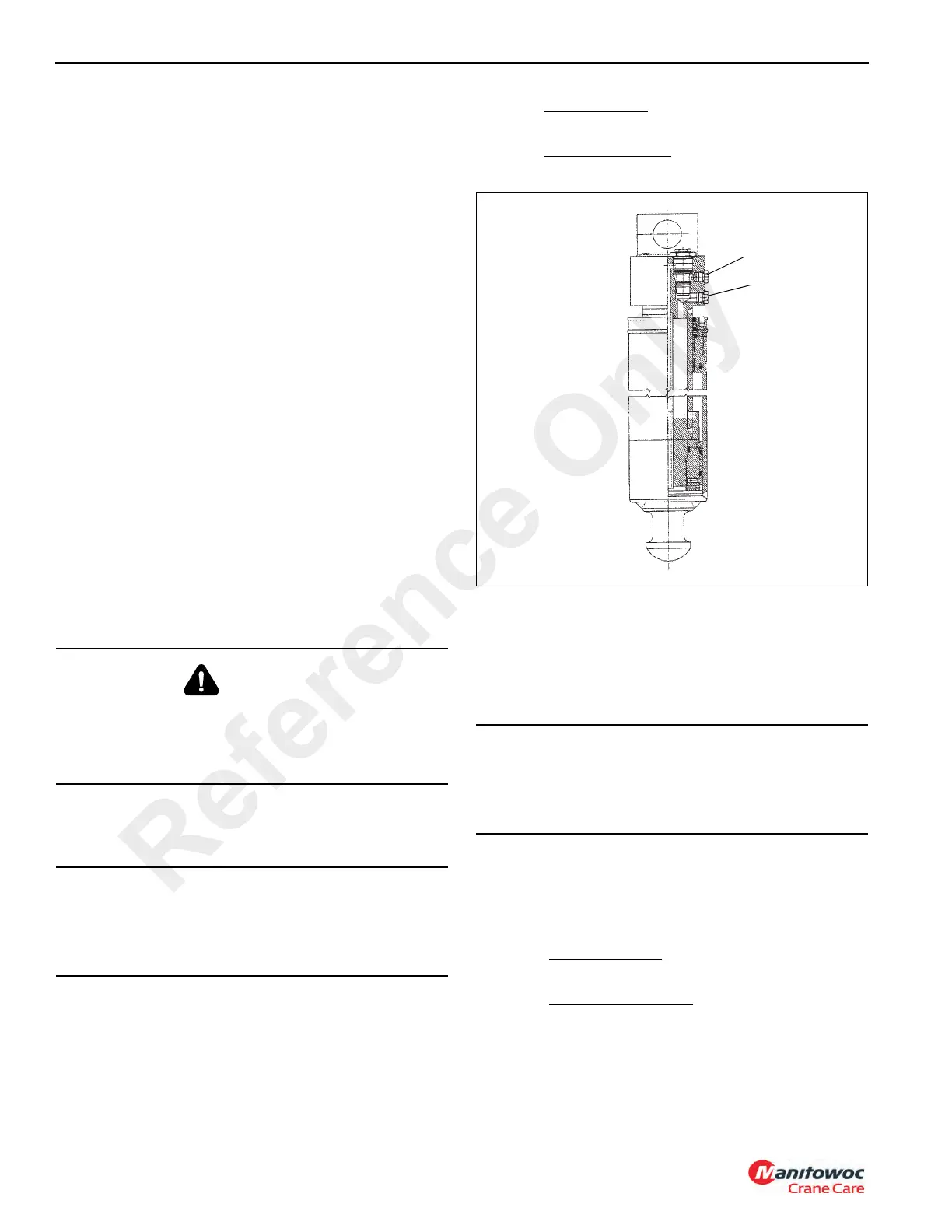UNDERCARRIAGE RT530E-2 SERVICE MANUAL
8-34 Published 4-22-15, Control # 556-00
the tube. Position the jack so that it will support the
cylinder in this position. Remove the lifting device from
the cylinder.
4. Remove the retaining pin and cotter pins from the
cylinder.
5. Lower the jack until the holes in the cylinder rod align
with the holes in the outrigger beam.
6. Apply anti-seeze compound to the retaining pin. Secure
the cylinder and cylinder cap retaining bracket to the
support tube with the retaining pin and cotter pins.
7. Install the cylinder cap.
8. Install the fittings in the cylinder ports and connect the
hoses as tagged during removal.
Functional Check
1. Activate the hydraulic system.
2. Extend and retract the jack cylinder.
3. Check for smooth operation of the cylinder.
4. Check all hydraulic connections and hoses for evidence
of leakage.
Outrigger Jack Cylinder Internal Leak Test
Use the following procedure to troubleshoot and diagnose an
internal leak, a leaking pilot operated check valve or a
thermal contraction on an outrigger jack cylinder.
Checking Cylinder For Internal Piston Seal Leak
1. Fully extend and set the outriggers.
2. Remove the rod side cylinder hose from the suspected
leaking jack cylinder (Figure 8-24). Oil will flow until the
cavity in the cylinder port block empties. Once the port
block cavity empties, oil should stop flowing from the rod
side port.
Check for the following conditions:
a. If oil stops flowing
, the cylinder’s internal piston seal
is sealing properly.
b. If oil continues to flow
out the rod port, the cylinder’s
internal piston seal is leaking.
3. After determining the condition of the cylinders internal
piston seal, let the rod side hose disconnected and
continue to test the pilot operated check valve.
Testing Pilot Operated Check Valve For Leakage
1. Fully extend and set the outriggers.
2. Remove the piston side cylinder hose from the
suspected leaking jack cylinder (Figure 8-24). Oil will
flow until the cavity in the cylinder port block empties.
Once the port block cavity empties, oil should stop
flowing from the piston side port.
a. If oil stops flowing
, the cylinder’s pilot operated
check valve is sealing properly.
b. If oil continues to flow
out the piston port, the
cylinder’s pilot operated check valve is leaking.
If oil flow is not noticed from either port, the cylinder and pilot
operated check valve are functioning properly, and any
cylinder contraction during normal operation can be
attributed to thermal contraction of the oil.
DANGER
Perform the following procedures with the crane
positioned on a firm level surface with outriggers fully
extended and set, and the crane in the travel position
Remove hoses from one cylinder at a time.
CAUTION
When performing step number 2, remove hose to adapter
connection slowly. Trapped pressure may exit between
the outrigger cylinder and the work port pilot operated
check valves in the outrigger selector valve.
CAUTION
When performing step number 2, remove hose to adapter
connection slowly. Trapped pressure may exit between
the outrigger cylinder and the work port pilot operated
check valves in the outrigger selector valve.
FIGURE 8-24
Piston Port
Rod Port
6432
Reference Only

